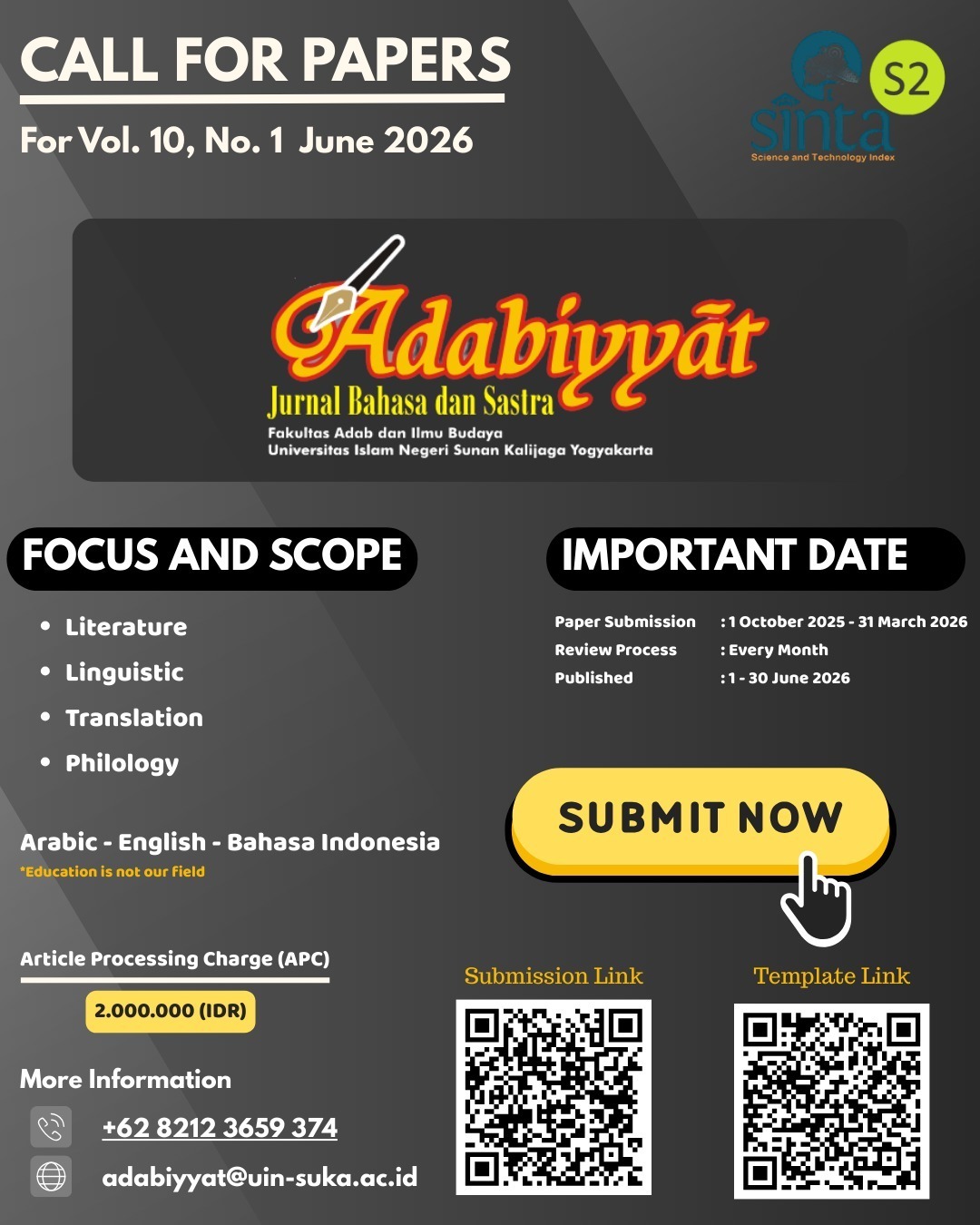TINJAUAN SEMIOTIK CULLER ATAS PUISI-PUISI ARAB SUFISTIS DALAM TEKS AL-TAṢAWWUF FI AL-SYI’R AL-‘ARABĪ KARYA ABD AL-H{AKĪM HASSĀN
DOI:
https://doi.org/10.14421/ajbs.2015.14102Abstract
The object of this study is Sufism Arabic Poetry that contains the views, ideals, and religious ideology of teh Arab. Despite its contents, which mostly talk about social life and love, there is a tendency that those poems contain as well the social anxiety. The material object of this study is the poem entitled ‘Al-Taṣawwuf fi al-Syi’r al-‘Arabī (2003) by H{aki>m Hassan. This study employs Jonathan Culler’s Semiotic Theory, which says that a poem is not just a series of sentences but it is an expression of the author’s mind as his asserion attitude toward society. Poetry also talks about author’s message and commitment on humanity. This study concluded that the Arabic poetry of Sufism is about signs that tell people to live their life at their best because life is only temporary (transient). In the perspective of Culler’s semiotic theory, the author has expressed his view in the poem and confirms its position on human life. In addition, the author also composes some verses of mystical poetry in the thematic scheme that echoes teachings of kindness and benevolence.Downloads
References
Alquran dan Terjemahnya. 1994. Departemen Agama Republik Indonesia. P.T. Kumudasmoro, Semarang.
Al-Sayyid, Syafī’. 2005. Naẓariyyat al-Adab, Dirāsah fi al-Madārisi al-Naqdiyyah al-Hadīsah. Kairo: Maktabah al-Ādāb.
Azzahra, Rizka Addini Fatimah. 2008. ‘Konsep Martabat Tujuh dalam Naskah Tasawuf”. Jakarta: Fakultas Ilmu Pengetahuan Budaya, Universitas Indonesia.
Basyūny, Ibrāhīm. 1969. Nasy`ah al-Taṣawwuf al-Islāmī. Kairo: Dārul-Ma’ārif.
Baylū, Shālih Adam. 1985. Min Qaḍāyā al-Adab al-Islāmī. Jeddah: Dārul-Manārah.
Braginsky, V.S. 1998. Yang Indah, Berfaedah dan Kamal, Sejarah Sastra Melayu dalam Abad 7–19. Jakarta: Indonesian-Netherlands Cooperation in Islamic Studies (INIS).
Calder, Norman et al. 2005. Classical Islam, A Sourcebook of Religious Literature. London and New York: Routledge.
Culler, Jonathan. 1981. Pursuit of Signs, Semiotics, Literature, Deconstruction. London: Routledge & Kegan Paul.
Eco, Umberto. 1992. Interpretation and Overinterpretation. New York: Cambridge University Press.
Ghazali, Muhammad al-. 1996. Perbarui Hidupmu. Judul asli Jaddid Hayātaka. Bandung: Gema Risalah Press.
Hakim, Taufiq al-. 1972. Fann al-Adab. Beirut: Dār al-Kitāb al-Lubnānī.
Hassān, Abd al-H{aki>m. 2003. Al-Taṣawwuf fi al-Syi’r al-‘Arabī. Kairo: Maktabatul-Adāb.
Hoesin, Oemar Amin. 1975. Kultur Islam, Sejarah Perkembangan Kebudayaan Islam dan Pengaruhnya dalam Dunia Internasional. Jakarta: Bulan Bintang.
Iser, Wolfgang. 1987. The Act of Reading, a Theory of Aesthetic Response. London: The John Hopkins University Press.
Istadiyanta. “Sastra Sufi Jawa dalam Bingkai Sastra Sufi Nusantara”. Solo: Fakultas Sastra dan Seni Rupa Universitas Sebelas Maret.
Jauziyyah, Ibnu al-Qayyim al-. 1999. Madāriju as-Sālikīna bayna Manāzili Iyyāka Na’budu wa Iyyāka Nasta’īn. Jilid II. Beirut: Dāru al-Kutubi al-‘Ilmiyyati.
Jauziyyah, Ibnu al-Qayyim al-. 2002. Ṭarīq al-Hijratain wa Bāb al-Sa’ādatayn. Makkah al-Mukarramah: Dār al-Ṭaybah al-Khadhrā`.
Knight. Mark. Emma Mason. 2006. Nineteenth-Century Religion and Literature. An Introduction. New York: Oxford University Press.
Landolt, Hermann. Samira Sheikh. 2008. An Anthology of Ismaili Literature, A Shiʿi Vision of Islam. London & New York: B.Tauris Publishers, in association with The Institute of Ismaili Studies.
Moleong, Lexi J. 2006. Penelitian Kualitatif. (Cetakan ke-25). Bandung: Rosdakarya
Nasr, Sayyid Husein. 1985. Tasauf, Dulu dan Sekarang. Judul asli Living Sufism. Diterjemahkan oleh Abdul Hadi WM. Jakarta: Pustaka Firdaus.
Qāsim, ‘Aun al-Syarīf. 1980. Fī Al-Ṭarīq ilā al-Islām. Beirut: Dāru al-Qalam.
Salam, Aprinus. 2003. “Politik Sastra Sufi, Negara, Ideologi: Latar Sosial-Politik Bangkitnya Puisi Sufi pada Tahun 1980-an hingga 1990-an”. Yogyakarta.
Schimmel, Annemarie. 2005. Jejak Abad Puisi Sufi. Bandung: Mizan.
Seung, T.K. 1992. Semiotics and Thematics in Hermeneutics. New York: Columbia University Press.
Shihab, M. Quraish. 2000. Lentera Hati, Kisah dan Hikmah Kehidupan. Bandung: Penerbit Mizan.
Sjukur, Asywadie. 1979. Ilmu Tasawuf II. Surabaya: P.T. Bina Ilmu.
Team Seowaps. 2012. “Tasawuf dalam Puisi Arab Modern: Studi Puisi Sufistik Abdul Wahab Al-Bayati” dalam http://www.seowaps.com/2012/03/puisi-tasawuf.html. diakses pada 5 Maret 2015.
Tisnowijaya, A. Sya’roni. 2008. “Tasawuf di Kalangan Intelektual Muhammadiyah Kota Semarang”. Semarang: Program Pascasarjana, Institut Agama Islam Negeri (IAIN) Walisongo Semarang.
Umari, Barmawi. 1990. Sistematik Tasawuf. Solo: Ramadhani.
Valiudin, Mir. 1987. Tasawuf dalam Alquran. Jakarta: Pustaka Firdaus.
Downloads
Published
Issue
Section
License
Copyright (c) 2015 Fadlil Munawwar Manshur

This work is licensed under a Creative Commons Attribution-ShareAlike 4.0 International License.
- Adabiyyāt: Jurnal Bahasa dan Sastra publishes all articles entirely in full text.
- It is permissible for readers to download and to use it for scientific purposes and scientific dissemination.
- The author can re-publish the article that has been published by the Adabiyyāt: Jurnal Bahasa dan Sastra after obtaining written permission from the editor. This letter can be obtained by submitting a request letter for permission to republish the article to Adabiyyāt: Jurnal Bahasa dan Sastra via email adabiyyat@uin-suka.ac.id. In the second publication, the author is required to include information that the article was firstly published by the Adabiyyāt: Jurnal Bahasa dan Sastra.









